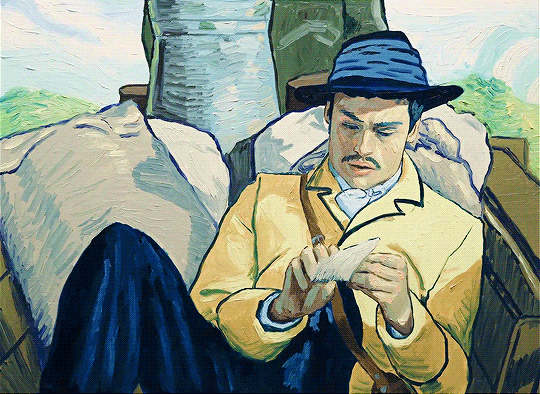
Brief Overview
Unlike other emotions, self-conscious emotions are fundamentally connected to the self, require complex thinking, and involve reflection and evaluation of the self. Over time, we develop an awareness of social presence and make comparisons with one another. We internalize our goals and standards from these emotions. There are four self-conscious emotions:
→Pride
→Embarrassment
→Guilt
→Shame

→Embarrassment
→Guilt
→Shame
Failure and Acceptance
As the film comes to a close end when Armand Roulin finally meets Dr. Gachet, Armand took the time to grow throughout each scene. He's had his fair share of pride through fist fights—for his family, for himself, for Vincent van Gogh. He rarely expressed embarrassment, which may be confused with guilt or regret when he made blind accusations of others who could not save Vincent from himself.

Guilt overpowers shame in Armand when he began to learn about Vincent and his struggles. From listening to his father's matter on mental health and family to arguing with the boatman. He was frustrated with himself, stuck in the present unable to fix the past. He had a desire to make things right although the artist was dead. When he encountered Marguerite in the fields, she saw his motivation to fix a wrong done to Vincent, but could not see who it would benefit.
"You want to know so much about his death, but what do you know of his life?" Armand could only comprehend a small piece of Vincent, feeling remorse. The only right he can do by Vincent was to deliver the letter to the rightful owner. Dr. Gachet may have an address to Theo's wife who he deemed is the next recipient of the letter. He came to him, prepared with the letter and information to interrogate the mysterious doctor everyone seemed to have a say about.
"I have to look after the health of great artists. It is a burden. They are not peaceful souls. I understand because I am an artist too. That is why they trust me."
Armand argued with Dr. Gachet, questioning him with everything to which the doctor countered—Vincent's mental state of mind (how he was calm and normal but in six weeks was unstable), convinced others agreed he was happy in Auvers-sur-Oise; his fame was rising (however he was growing lonelier the more he became famous); he received love from his brother and friendship from others (but he was afraid of the future), and so on.
The more Armand questioned Dr. Gachet, the more he began to understand who Vincent was and how the events that lead up to his death happened. He still believed the artist was covering up for someone who had shot him, but Dr. Gachet blamed himself for the turn of events because was angered by the artist's harsh words.
"Vincent's biggest fear was that the burden of him would bring down his brother [...] I think he took his life to try and save Theo because of something I said. [...] Vincent said I was living a lie while he lived and struggled for the truth."
"I'm wondering if people will appreciate what he did."


Comments
Post a Comment